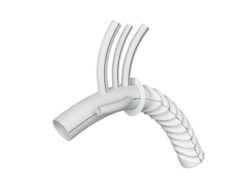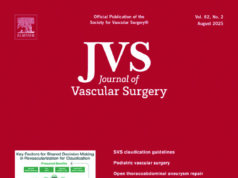
Many of you may have already heard about the controversial Comparative Billing Reports (CBRs) that have been received by some of our vascular surgery colleagues. In case you haven’t, this is your chance to catch up and to prepare for a possible insurance denial that may occur in the setting of a clinically-indicated intervention for debilitating claudication after a trial of exercise therapy and for critical limb ischemia (CLI).
The Centers for Medicare and Medicaid Services (CMS) sends a CBR document comparing procedures by a physician with those of others in the country. A flurry of CBRs has surprised some SVS members and seem to suggest that these physicians were not using any exercise therapy prior to performing interventions on patients with intermittent claudication.
The CBRs might seem reasonable if valid; however, the evaluation process was flawed. CMS hired an independent company to look at all the patients who had a peripheral vascular intervention with an ICD-10 code for intermittent claudication (IC) and whether there was a CPT code for Supervised Exercise Therapy (SET) within three months preceding the intervention. It did not matter if there was also an ICD-10 code for rest pain or tissue loss, or if the patients had received an adequate trial of exercise therapy but it hadn’t been billed as SET. The company employees did not take into consideration clinical settings in which exercise therapy would not be indicated, such as a failing bypass or stent with claudication.
Despite all of this, this group found very few physicians who were outliers with the raw data. The company added criteria, and finally sent the billing reports to those above the 90th percentile or below the 10th percentile (per the CBR letters). While the consulting company did have some consulting physician input, those doing the review did not seek the opinions or guidance from vascular surgeons in the development of this document, known as CBR202004. The timeframe was Dec. 1, 2018, to Nov. 30, 2019, and all the CBR202004 letters have been delivered.
In addition to CBRs, some private insurance companies have denied coverage for interventions for IC. Again, the basis of such denials seemed to be whether SET was billed, rather than whether exercise therapy was tried. These companies have instituted new policies that were not widely announced but posted to their websites and caught many off guard.1,2 SET is not required by CMS before a peripheral vascular intervention (PVI) for regular Medicare patients. However, patients enrolled in Medicare Advantage programs may be required to have SET or structured exercise therapy along with prior authorization for some IC interventions.
SET, as defined by CPT code 93668, is 45 to 60 minutes of rehabilitative physical exercise on a motorized treadmill or track supervised by an exercise physiologist or nurse. This can only be done in a hospital or a physician office setting and requires a supervising physician or physician extender trained in ACLS.3,4 This CPT code was not developed until 2017 and widespread payment was not available until 2018. It is still not well-compensated, which is probably a reason why this service is neither widely known nor easily available. In addition, there are numerous patient factors and logistical issues that prevent such a service from being used even if it were available. SET is not routinely ordered by physicians and thus not billed by them. Most such programs are run by cardiac rehabilitation centers.
In response, the SVS Coding Committee and others have sent letters to CMS about this CBR, pointing out how such an assessment could have been done in a more accurate manner if the specialty societies involved would have been consulted before the data were extracted. SVS strongly recommends exercise therapy for IC before interventions.5 SVS is involved in developing an app-based SET program that could overcome many logistical issues and make it easier for patients to use it.
There are a few steps that can be taken to avoid issues with reimbursement for IC interventions. Remember to use only the most specific ICD-10 code for vascular disease for billing procedures. Do not use a generic claudication code if more advanced vascular disease is present (I70.22 family for rest pain, I70.23 family for ulceration, I70.26 family for gangrene), or if there is a failing bypass (T82.856A) or stent (T82.599A).6 Document clearly if a patient is simply not a candidate for exercise therapy due to other comorbidities. This may also be a good time to look into partnership with cardiac rehab programs in your area to see if they can offer SET for vascular patients with intermittent claudication by incorporating protocols such as Gardner Skinner protocol.6
The attention of CMS to unwarranted peripheral interventions is both important and timely but the process by which the agency has sought to determine this is deeply flawed. Current practices and SVS guidelines for exercise therapy, including SET, are well-established. Physicians should be able to determine the most effective options for management of peripheral vascular disease in accordance with current guidelines and after careful consideration of individual patient factors.
References
- https://www.anthem.com/dam/medpolicies/ abcbs/active/guidelines/gl_pw_c183076.html
- https://www.uhcprovider.com/ content/dam/provider/docs/public/ policies/comm-medical-drug/lower-extremity-vascular-angiography.pdf
- https://www.cms.gov/Outreach-and-Education/Medicare-Learning- Network-MLN/MLNMattersArticles/ Downloads/MM10295.pdf
- https://www.cms.gov/medicare-coverage-database/details/nca-decision-memoaspx?N CAId=287&CoverageSelection=National&K eyWord=supervised+exercise+therapy&Ke yWordLookUp=Title&KeyWordSearchType= And&bc=gAAAACAACAAAAA%3D%3D&
- Conte M.S., Pomposelli F.B., Clair D.G., Geraghty P.J., McKinsey J.F., Mills J.L., Moneta G.L., Murad M.H., Powell R.J., Reed A.B., Schanzer A., Sidawy A.N. Society for Vascular Surgery practice guidelines for atherosclerotic occlusive disease of the lower extremities: Management of asymptomatic disease and claudication. J Vasc Surg. Volume 61, issue 3, supplement, 2s-41s.e1, March 01, 2015
- Treat-Jacobson D., McDermott M.M., Beckman J.A., Burt M.A., Creage M.A., Ehrman J.K., Gardner A.W., Mays R.J., Regensteiner J.G., Salisbury D.L., Schorr E.N., Walsh M.E. Implementation of Supervised Exercise Therapy for Patients with Symptomatic Peripheral Artery Disease: A Science Advisory from the American Heart Association. Circulation. Volume 140, Issue 13, 24 September 2019; Pages e700-e710 https:// doi.org/10.1161/CIR.0000000000000727
Neelima Katragunta, MD, and Kevin Martin, MD, are members of the SVS Coding Committee.












